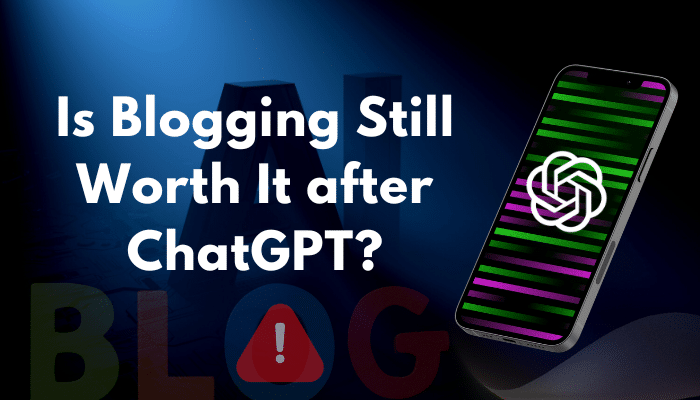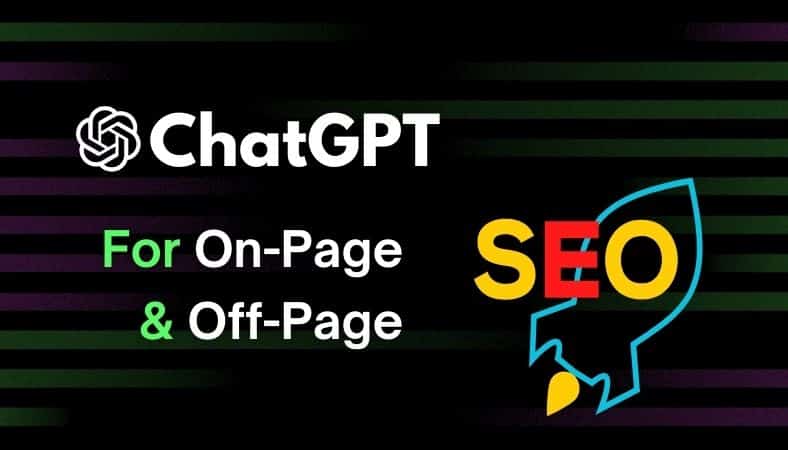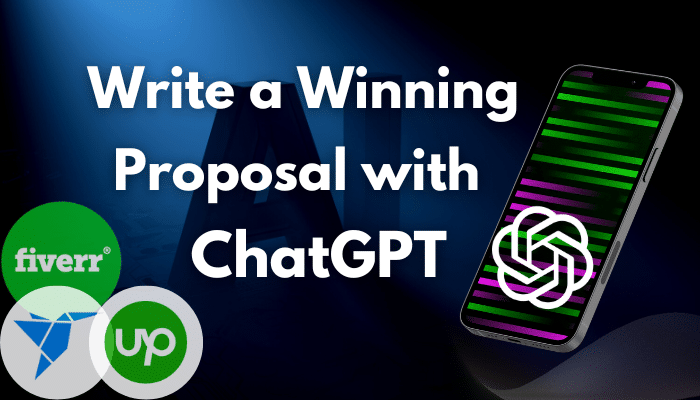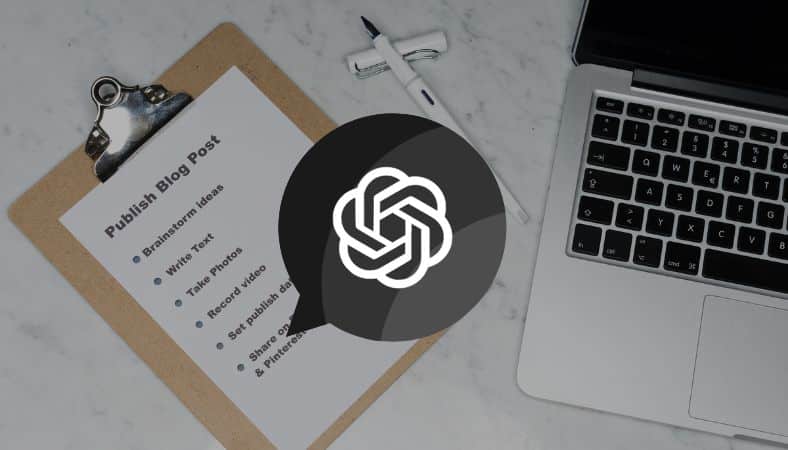As the job market becomes more competitive, employers are constantly searching for ways to streamline their hiring processes and find the best candidates. One tool that has become increasingly popular in recent years is ChatGPT. In this article, we’ll explore how ChatGPT can be a wonderful tool for employers and why it’s worth considering for your hiring needs.
Related: Tips to turn interview into offer using ChatGPT.
What is ChatGPT?
Before we dive into the benefits of using ChatGPT for employers, let’s first discuss what it is. ChatGPT is a language model developed by OpenAI, designed to generate human-like text responses to prompts or questions. It’s trained on a massive amount of text data and uses natural language processing (NLP) to understand the context and meaning behind words and phrases.
How does ChatGPT work?
ChatGPT works by analyzing the text prompt given to it and generating a response that is as human-like as possible. It uses machine learning algorithms to identify patterns in language and generate new text based on those patterns. The more text data it’s trained on, the better it becomes at generating accurate and relevant responses.
Benefits of Using ChatGPT for HR Processes
The following are some of the benefits of using ChatGPT for HR processes:
24/7 Availability
ChatGPT can be used round the clock, enabling employees to get their queries resolved instantly. This feature is particularly useful for organizations that have employees working in different time zones.
Personalized Responses
ChatGPT can analyze vast amounts of data and provide personalized responses to employees based on their queries. This feature can improve employee engagement and satisfaction.
Improved Productivity
By automating repetitive tasks and answering frequently asked questions, ChatGPT can improve employee productivity.
Cost-Effective
ChatGPT can help organizations save costs by reducing the need for human intervention in HR processes.
Scalability
ChatGPT can handle a large number of queries simultaneously, making it an ideal solution for organizations.
How Can Employers Use ChatGPT in Their HR Processes?
Recruitment Process
ChatGPT can help employers automate the initial screening process by providing a set of predefined questions for job candidates.
This means that recruiters don’t need to spend time coming up with questions related to a specific job position during the interview process. Instead, ChatGPT can provide a list of questions that are relevant to the job requirements, skills, and experience needed for the role. This can help recruiters quickly filter out unsuitable candidates and save time during the hiring process.
My Prompt: I’m an employer and have to interview an employee for the job of graphics designer with 3 years experience in 3D animation. Write 10 questions for me.
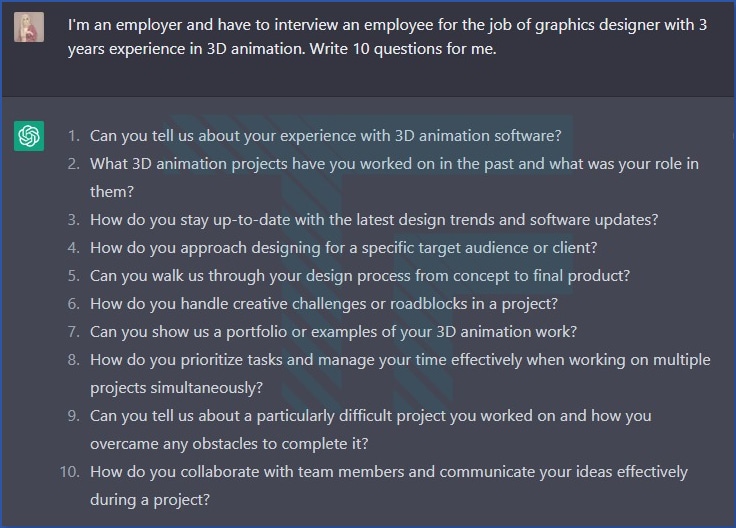
Additionally, ChatGPT can also help to reduce unconscious bias in the screening process, as the same set of questions is asked of all candidates, eliminating any subjective or inconsistent questioning.
Overall, by using ChatGPT for initial candidate screening, employers can streamline their recruitment process, improve the efficiency of their hiring efforts, and ultimately make better hiring decisions.
Training and Development
ChatGPT can help employees improve their skills and knowledge by creating personalized training plans based on their performance and career goals. For instance, if an employee wants to develop leadership skills, ChatGPT can suggest relevant courses or resources.
My Prompt: I want to learn leadership skills. Suggest me some courses.
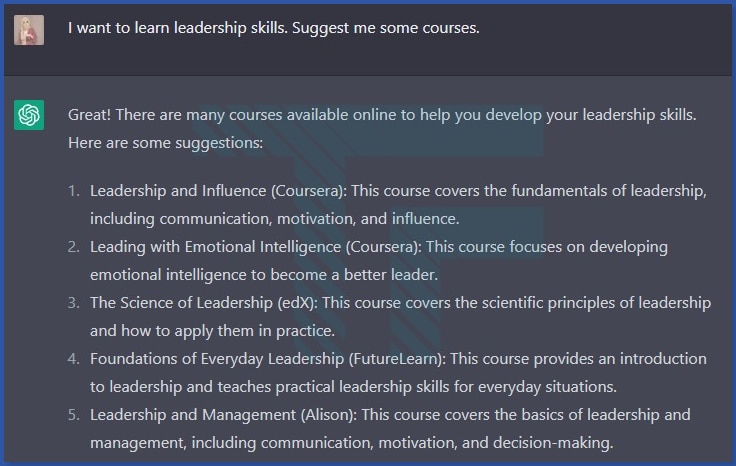
Similarly, if an employee needs to improve in a particular area, such as public speaking or project management, ChatGPT can recommend relevant training programs or coaching resources.
ChatGPT can also suggest relevant courses and resources for ongoing learning and development based on an employee’s job function, industry, or career goals.
Performance Management
ChatGPT can help track employee performance and provide feedback to managers. It can also be used to set goals and conduct performance reviews.
By using ChatGPT, managers can identify areas where employees need improvement and provide targeted training and support. This can help employees to develop their skills and grow in their roles.
Additionally, ChatGPT can provide data and insights to help managers make informed decisions about promotions, salary increases, and other forms of recognition.
Example: Let’s say that an employee named Sarah works as a customer service representative at a retail company. Her manager, John, wants to track her performance and provide feedback to help her improve.
John sets up a chat with ChatGPT and enters Sarah’s performance data, such as her call handling time, customer satisfaction scores, and the number of tickets resolved.
Based on this data, ChatGPT generates a report that shows Sarah’s strengths and weaknesses.
John can use this report to provide targeted feedback and coaching to help Sarah improve her performance. For example, if Sarah’s call handling time is high, John might suggest some tips for improving her efficiency on the phone.
Additionally, ChatGPT can help John set goals for Sarah and track her progress over time. For instance, John might set a goal for Sarah to reduce her call-handling time by 10% within the next month.
By using ChatGPT to track employee performance and provide feedback, John can help Sarah improve her skills and grow in her role as a customer service representative.
Employee Engagement
ChatGPT can help organizations conduct employee surveys to gather feedback and measure employee engagement.
For example, let’s say that a company wants to get feedback from its employees about their work-life balance. They can set up a chat with ChatGPT and create a survey with questions about workload, work hours, and other factors that impact work-life balance.
Employees can answer the survey questions and then the data is collected and analyzed. Based on the survey results, the company can identify areas where they need to improve to support their employees’ well-being and job satisfaction.
In addition to conducting surveys, ChatGPT can also provide personalized benefits and perks to employees.
For instance, ChatGPT can recommend wellness programs or fitness classes based on an employee’s interests or health goals. It can also suggest relevant financial wellness resources, such as retirement planning tools or investment advice.
By using ChatGPT to provide personalized benefits and perks, organizations can improve employee engagement, satisfaction, and retention. Employees feel valued and supported when their employer invests in their well-being and helps them achieve their personal and professional goals.
Compliance and Regulations
ChatGPT can help ensure compliance with regulations and policies by providing employees with relevant information and resources.
For example, let’s say that a company operates in a highly regulated industry such as finance or healthcare. They can set up a chat with ChatGPT and provide employees with access to information about the relevant laws, regulations, and policies that they need to follow.
ChatGPT can also answer employees’ questions and provide guidance on how to comply with regulations and policies in their day-to-day work.
In addition, ChatGPT can help employees report any incidents or issues that violate the company’s policies, such as harassment or discrimination.
Best Practices for Using ChatGPT in HR Processes
To get the best results from ChatGPT in HR processes, organizations should consider the following best practices:
Define Clear Objectives
Organizations should define clear objectives for using ChatGPT in their HR processes, such as improving employee engagement or reducing costs. This can help them measure the effectiveness of ChatGPT and make improvements where necessary.
Provide Clear Guidance
Organizations should provide clear guidance to employees on how to use ChatGPT and what queries it can and cannot handle. This can help prevent frustration and ensure that employees get the right answers to their queries.
Monitor and Analyze the Data
Organizations should monitor and analyze data on how ChatGPT is being used, the types of queries being asked, and the response times. This can help identify areas for improvement and optimize the system for better performance.
Train Employees
Organizations should train employees on using ChatGPT effectively and encourage them to provide feedback on its performance. This can help improve the quality of the responses and enhance employee engagement.
How to Implement ChatGPT in your Business?
Implementing ChatGPT in your business can be a game-changer, but it can also be a challenging task. To help you get started, here are some steps to follow:
Identify the Use Case
The first step is to identify the specific use case for ChatGPT in your business. For example, you might want to use it to automate customer service or provide personalized training and development plans for employees. Once you’ve identified the use case, you can determine how ChatGPT can be integrated into your existing processes and systems.
For instance, let’s say that you run an e-commerce business, and you want to use ChatGPT to automate customer support. In this case, you can integrate ChatGPT with your website and social media channels so that customers can get instant support.
Choose the Right Platform
There are several platforms available for implementing ChatGPT, such as Microsoft Azure, IBM Watson, and Google Dialogflow. It’s important to choose a platform that is flexible and can be easily integrated into your existing systems.
For example, if you’re already using Microsoft products in your business, you might choose Microsoft Azure as your ChatGPT platform.
Train ChatGPT
Once you have chosen a platform, the next step is to train ChatGPT. This involves feeding it with data and training it to understand the specific queries and responses required for your business.
For example, if you’re using ChatGPT to automate customer support, you can train it to recognize common customer questions and provide relevant answers. You can also provide it with information about your products, policies, and procedures.
Test and Refine
After training, it’s important to test ChatGPT and refine its responses. This will ensure that it is providing accurate and relevant responses to users.
For example, you can conduct user testing to see how customers interact with ChatGPT and gather feedback on its performance. You can also analyze the data to identify any areas where ChatGPT needs improvement and refine its responses accordingly.
By following these steps, you can implement ChatGPT effectively and reap the benefits of automation and personalization in your business.
Bonus: 15 Ways to Use ChatGPT to Boost your Marketing Strategy
Conclusion
In conclusion, ChatGPT is an AI-powered chatbot that can help businesses improve their productivity and efficiency. Employers can use ChatGPT in a variety of ways to streamline their operations, improve customer service, and automate administrative tasks. Implementing ChatGPT in your business requires careful planning and execution, but with the right approach, it can be a valuable asset to your organization.
Frequently Asked Questions:
ChatGPT can help employers automate the initial screening process by providing a set of predefined questions for job candidates. This can help recruiters quickly filter out unsuitable candidates and save time during the hiring process.
ChatGPT is a language model developed by OpenAI that generates human-like text responses to prompts or questions. Employers should care because it can help streamline their HR processes, improve productivity, and save costs.

